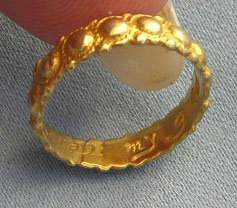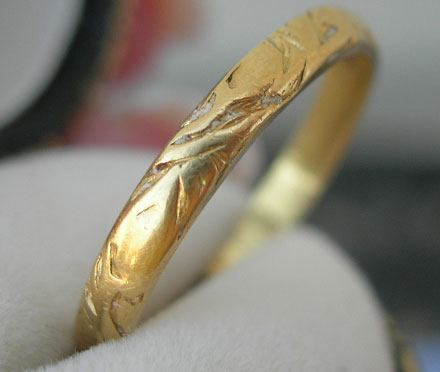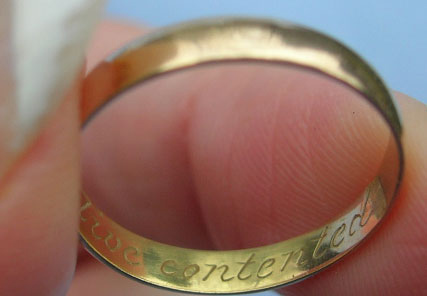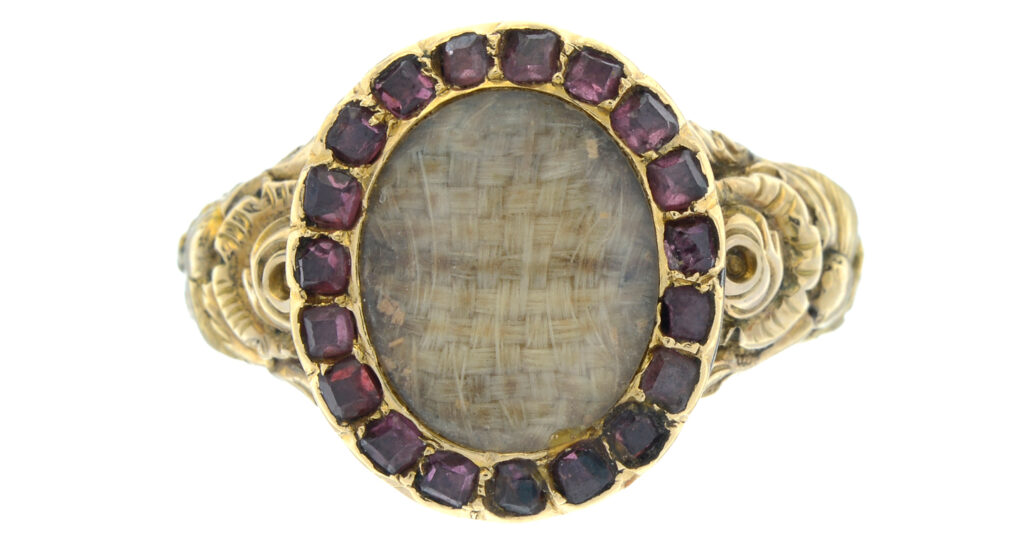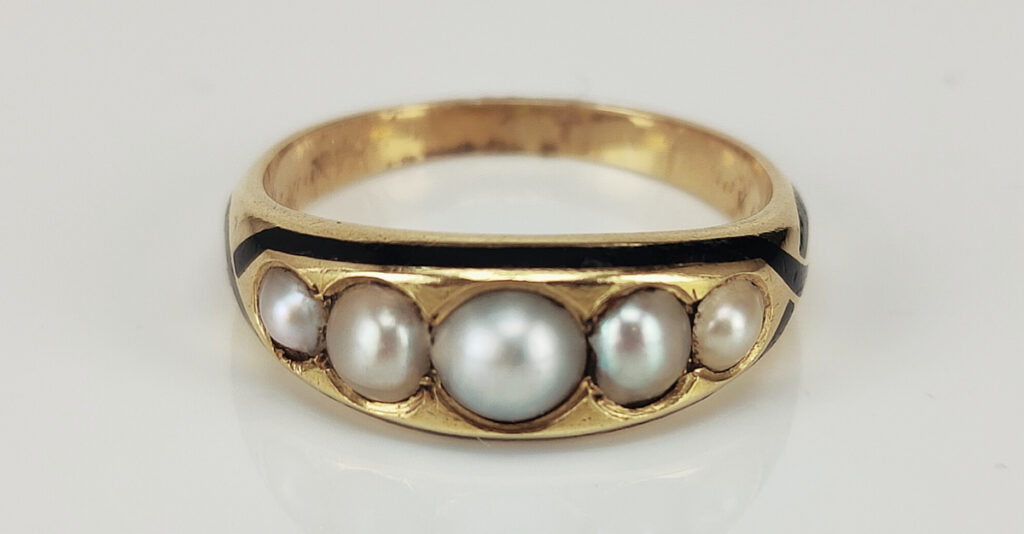A Mourning Tour: Posie Rings
Posie rings, otherwise known as ‘poesy’, ‘posy’ or ‘posey’, are one of the primary catalysts for the mourning and sentimental rings that generated their own industry post 1680.
Without the standardisation of the English language and the written reliance on Latin previous to the dictionary in 1755, posie rings are a remarkable time capsule for phonetically capturing their surrounding language in a jewel. From a status perspective, this utilisation of language is accessible to a strata of society that didn’t have the luxury of formalised education, opening up sentimental jewels to new levels of society. Basic sentiments of love etched into silver and gold bands could now be given as a secret love token for a growing middle class. In rings previous to the 16th century, more common would be the inscriptions written in French, Latin and Norman French.
Chapbooks, pamphlets containing popular literature, were a popular source for many of the sentiments written inside the posie rings. These cheap pamphlets grew in popularity, as they were sold cheaply (commonly a penny or halfpenny) and contained many popular ballads from the time. This pre-dates mass produced media of the early 19th century, when steam presses led to the rise of cheap newspapers. From the mid 16th century, these cheap and crudely produced booklets contained relevant popular content that varied from entertainment to political and religious content. Here, the relation of the ring to the popular literature is the key factor in understanding just how the posie’s relation to society. They were jewels that could be for the commoner, but also transient as a style of love token through society because of their simple statements.
From a design perspective, posie rings are very random in their styles. Without a popular and fluid fashion/art movement to adapt to and no major industry to produce the affectations of fashion throughout a multi-structured society, the designs are disparate and may contain popular elements or may be basic bands. This makes identification of the simple bands difficult, unless the language can be identified, but within a bracket of the 16th to early 18th centuries, elements can be identified within a set number of years.
This particular ring shows its design elements through the band and that makes it easier to put at he middle of the 17th century, a time just before the industry of mourning and sentimental jewels was to be established during the Restoration.
Look towards the nature of hair and its status as a gift in jewellery from the 17th century. Prior to the rise of the hairworking industry and its prominence in mainstream jewellery, gifts of hair were considered tokens of affection and love between two people. Bury refers to The Relique (or The Relic) by poet John Donne (1572-1631) and its very early reference to a hair bracelet:
“When my grave is broke up againe
Some second ghest to entertaine,
(For graves have learn’d that woman-head
To be to more than one a Bed)
And he that digs it, spies
A bracelet of bright haire about the bone,
Will he not let us alone,
And thinke that there a loving couple lies”
Donne speaks in metaphysical terms about the unifying nature of spiritual love, as when he and his lover are dug up, they remain the symbol for holy and eternal love. From this, the poem is an excellent perspective on the sentimentality of hairwork at the turn of the 17th century. Wearing hair was an encompassing symbol of union and love between two people.
Donne wasn’t unique in his wearing of a hair bracelet, however, as Count de Grammont viewed several people wearing hairwork bracelets in the Court of the restored Charles II, circa 1660. This ties in with the rising prominence of other sentimental jewellery at that time. From love tokens, such as posy rings, to hair woven under crystal in slides, brooches, rings and other forms of jewellery, sentimental jewellery was rapidly evolving over the 17th century. Within these forms of sentimental jewellery, the use of hair became ever more prominent. Another example from 1647/8 of the popularity of hairwork within mainstream culture can be seen in Mary Varney’s letter to Sir Raplh Varney, asking to send locks of their daughter’s hair “to make bracelets? I know you could not send a more acceptable thing than every one of your sisters a bracelet”. At the time, Ralph was living in exile in France during the Protectorate. Hair tokens within families was the more common practice, but as jewels grew as a social device, so did their nature as a personal statement.
Here, we have a wonderful statement of ‘Let vertue bee a guide’. The token of love from the gift of a posie ring related to personal dedications between two people. With the dedication being hidden on the underside of the band itself, the sentiment wasn’t one that portrayed the intrinsically personal nature of the self to the public. Which brings into context the nature of the sentiment and why it was given.
The sentiment is very closely related to Aemilia Lanyer’s (Emilia Lanier) (1569-1645) poems from “Salve Deus Rex Judaeorum” (1611) and To all vertuous Ladies in generall:
Each blessed Lady that in Virtue spends
Your pretious time to beautifie your soules;
Come wait on hir whom winged Fame attends
And in hir hand the Booke where she inroules
Those high deserts that Majestie commends:
Let this faire Queene not unattended bee,
When in my Glasse she daines her selfe to see.Put on your wedding garments every one,
The Bridegroome stayes to entertaine you all;
Let Virtue be your guide, for she alone
Can leade you right that you can never fall;
And make no stay for feare he should be gone:
But fill your Lamps with oyle of burning zeale,
That to your Faith he may his Truth reveale.Let all your roabes be purple scarlet white,
Those perfit colours purest Virtue wore,
Come deckt with Lillies that did so delight
To be preferr’d in Beauty, farre before
Wise Salomon in all his glory dight:
Whose royall roabes did no such pleasure yield,
As did the beauteous Lilly of the field.
This defence of ‘virtuous women’ is a powerful statement of femininity of its time and here we have it represented in a ring that correlates roughly to the publication, and popularity, of the poem. If this consideration is correct, then there is the factor of the relationship between the couple that the ring represented to understand. From the allusion to the vows of marriage and the ideal status of the female, the assumption that the posie ring is a prelude to marriage, or a fundamental gift of love cannot be understated.
For its time, this is a wonderful statement, with the consideration it was a gift from a man to a woman. Its perception of the relationship, with the virtue of the female being an element of pride brings into context the surrounding social strata that would have produced the ring. It is a basic design, but with fine detail to the etching of the dedication. The typography is quite similar to that seen in mourning jewels of the 17th and 18th centuries – note the curl to the ‘L’ and the balance to the script. From this, we can see that the ring was not crude for its time, putting it at the higher end of society and not something crudely made. This ring was found in Bath, Somerset but that does not indicate that its history relates to there, given that social movement would have been common; however, the ring does have its history there and with the economic status of Bath, the consideration of this ring to be of higher society.
Posie rings are wonderful time capsules. Without the obvious design flourishes that indicate their times, much time must be spent with them to extrapolate their meaning and the interpersonal nature of their existence. Their true nature, on the whole, is an assumption on the part of the historian to understand them and their times, yet that will never discredit the fundamental nature of love between two people in which the ring was given.
With sentimentality and love being popular and affordable in jewellery from the 15th century and the growing act of giving oneself through a jewel or hair, posie rings are the ideal tokens of affection for their time. Be it for love or mourning, the concept of the jewel to remember someone by was cemented through the giving of a posie ring in early modern times.




